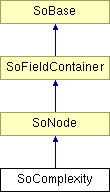
#include <Inventor/nodes/SoComplexity.h>
Inheritance diagram for SoComplexity::

Public Types | |
| enum | Type { OBJECT_SPACE = SoComplexityTypeElement::OBJECT_SPACE, SCREEN_SPACE = SoComplexityTypeElement::SCREEN_SPACE, BOUNDING_BOX = SoComplexityTypeElement::BOUNDING_BOX } |
Public Methods | |
| SoComplexity (void) | |
| virtual void | doAction (SoAction *action) |
| virtual void | callback (SoCallbackAction *action) |
| virtual void | getBoundingBox (SoGetBoundingBoxAction *action) |
| virtual void | GLRender (SoGLRenderAction *action) |
| virtual void | pick (SoPickAction *action) |
| virtual void | getPrimitiveCount (SoGetPrimitiveCountAction *action) |
Static Public Methods | |
| void | initClass (void) |
Public Attributes | |
| SoSFEnum | type |
| SoSFFloat | value |
| SoSFFloat | textureQuality |
Protected Methods | |
| virtual | ~SoComplexity () |
By inserting SoComplexity nodes in the scene graph, you can control the accuracy by which complex shapes are rendered and the quality of the texture mapping used for geometry in the scene.
Shape nodes like SoCone, SoSphere, SoCylinder and others, will render with fewer polygons and thereby improve performance, if the complexity value of the traversal state is set to a lower value.
By using the SoComplexity::type field, you may also choose to render the scene graph (or parts of it) just as wireframe bounding boxes. This will improve rendering performance a lot, and can sometimes be used in particular situations where responsiveness is more important than appearance.
Texture mapping can be done in an expensive but attractive looking manner, or in a quick way which doesn't look as appealing by modifying the value of the SoComplexity::textureQuality field. By setting the SoComplexity::textureQuality field to a value of 0.0, you can also turn texturemapping completely off.
|
|
The available values for the SoComplexity::type field.
|
|
|
Constructor. |
|
|
Destructor. |
|
|
Sets up initialization for data common to all instances of this class, like submitting necessary information to the Coin type system. Reimplemented from SoNode. |
|
|
This function performs the typical operation of a node for any action. Reimplemented from SoNode. |
|
|
Action method for SoCallbackAction. Simply updates the state according to how the node behaves for the render action, so the application programmer can use the SoCallbackAction for extracting information about the scene graph. Reimplemented from SoNode. |
|
|
Action method for the SoGetBoundingBoxAction. Calculates bounding box and center coordinates for node and modifies the values of the action to encompass the bounding box for this node and to shift the center point for the scene more towards the one for this node. Nodes influencing how geometry nodes calculates their bounding box also overrides this method to change the relevant state variables. Reimplemented from SoNode. |
|
|
Action method for the SoGLRenderAction. This is called during rendering traversals. Nodes influencing the rendering state in any way or who wants to throw geometry primitives at OpenGL overrides this method. Reimplemented from SoNode. |
|
|
Action method for SoPickAction. Does common processing for SoPickAction action instances. Reimplemented from SoNode. |
|
|
Action method for the SoGetPrimitiveCountAction. Calculates the number of triangle, line segment and point primitives for the node and adds these to the counters of the action. Nodes influencing how geometry nodes calculates their primitive count also overrides this method to change the relevant state variables. Reimplemented from SoNode. |
|
|
Set rendering type. Default value is SoComplexity::OBJECT_SPACE. |
|
|
Complexity value, valid settings range from 0.0 (worst appearance, best perfomance) to 1.0 (optimal appearance, lowest rendering speed). Default value for the field is 0.5. Note that without any SoComplexity nodes in the scene graph, geometry will render as if there was a SoComplexity node present with SoComplexity::value set to 1.0. |
|
|
Sets the quality value for texturemapping. Valid range is from 0.0 (texturemapping off, rendering will be much faster for most platforms) to 1.0 (best quality, rendering might be slow). The same value for this field on different platforms can yield varying results, depending on the quality of the underlying rendering hardware. |
 1.2.9 written by Dimitri van Heesch,
© 1997-2001
1.2.9 written by Dimitri van Heesch,
© 1997-2001